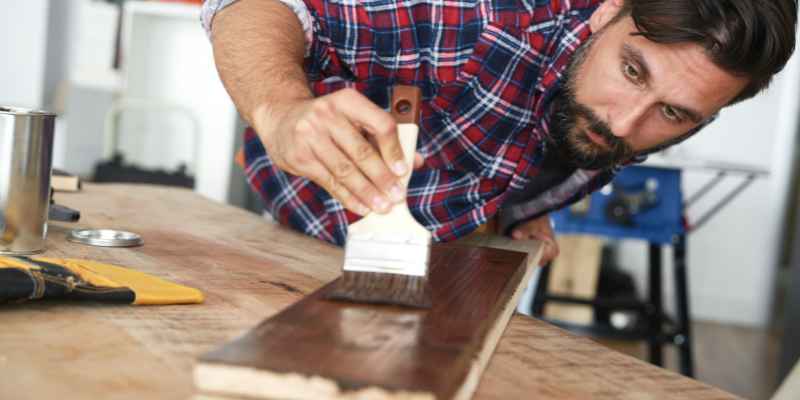Yes, you can seal treated wood to protect it from moisture and UV light damage. By sealing treated wood, you can extend its lifespan and maintain its quality.
Pressure-treated wood, although initially treated with chemicals, still requires additional sealing to ensure long-lasting durability and protection. Staining and sealing the wood helps to prevent water absorption and enhance its resistance to environmental elements. Knowing when and how to seal pressure-treated wood is essential to preserve its integrity and appearance over time.
Proper sealing also plays a crucial role in maintaining the structural integrity of outdoor wooden structures, such as decks and fences. Choosing the right sealing products and techniques will ensure the longevity and beauty of your treated wood projects.
Understanding Treated Wood
Pressure-treated wood should be sealed to protect it from moisture and ultraviolet light, extending its lifespan. You can use products like paint, stain, or clear sealers to seal treated wood, depending on your desired aesthetic and environmental conditions. However, it is important to allow the wood to dry for at least six months before applying any treatment.
What Is Treated Wood?
Treated wood is wood that has been specially treated with preservatives to protect it from rot, decay, and insect damage. The treatment process involves applying chemicals under high pressure to penetrate the wood fibers, making it more resistant to outdoor elements.
Benefits Of Treated Wood
- Protection: Treated wood offers enhanced protection against decay, rot, and insect infestation, prolonging its lifespan.
- Durability: The treatment process makes the wood more durable, allowing it to withstand harsh environmental conditions.
- Versatility: Treated wood is suitable for a wide range of outdoor applications, including decking, fencing, and outdoor furniture.
- Cost-effectiveness: It provides long-term cost savings by reducing the need for frequent maintenance and replacements.
Sealing treated wood is essential to further enhance its protective properties. It helps to prevent moisture penetration, UV damage, and maintains the wood’s appearance over time.
Pressure-treated wood, despite its inherent resistance, can benefit from sealing to ensure optimal longevity and performance.
Can You Seal Treated Wood?
Sealing treated wood is crucial to enhance its longevity and protect it from various elements.
Importance Of Sealing Treated Wood
Sealing treated wood helps protect it from moisture, UV light, and decay, extending its lifespan.
When To Seal Treated Wood
- Pressure-treated wood should be allowed to dry for at least six months before sealing.
- If water beads on the wood surface, it’s still too wet for sealing.
Applying a sealant on pressure-treated wood can prevent it from absorbing excess water and potentially rotting.
Sealing treated wood with paint, stain, or clear sealers depends on factors like aesthetics and environmental conditions.
How To Seal Treated Wood
To preserve and extend the life of treated wood, sealing is crucial. Even though pressure-treated wood is resistant, sealing it protects against moisture and UV damage. Ensure the wood is dry before applying any sealant for optimal effectiveness and longevity.
Choosing The Right Sealant
When it comes to sealing treated wood, it’s important to choose the right sealant. There are several options available, including paint, stain, and clear sealers. The choice depends on various factors, such as the desired aesthetic, level of maintenance, and environmental conditions.
Application Process
To seal treated wood, follow these simple steps for a successful application process:
- Clean the Surface: Before sealing, make sure the wood surface is clean and free from debris. You can use a brush or a power washer to remove dirt, dust, and stains. Allow the wood to dry completely before moving to the next step.
- Choose the Right Day: It’s best to choose a dry and mild day for sealing, as moisture can interfere with the sealing process. Avoid sealing on rainy or extremely hot days.
- Apply the Sealant: Start by stirring the sealant thoroughly to ensure proper mixture. Use a brush or roller to apply an even coat of sealant on the wood surface. Make sure to follow the manufacturer’s instructions for application and drying time.
- Allow Drying Time: After applying the sealant, allow it to dry completely before using or exposing the wood to any moisture. This drying time can vary depending on the type of sealant used, so be sure to check the instructions.
- Inspect and Reapply: Once the initial coat has dried, inspect the surface for any missed areas or thin spots. If necessary, apply a second coat of sealant to ensure complete coverage and protection.
Sealing treated wood is crucial to protect it from moisture, ultraviolet light, and other environmental factors. By following these steps and choosing the right sealant, you can ensure that your treated wood stays protected and extends its lifespan.
Staining Treated Wood
Staining treated wood is an essential step in protecting and enhancing the lifespan of your outdoor furniture, decks, and other wooden structures. Despite pressure-treated wood’s resistance to rot and decay, it is still vulnerable to moisture and UV light. Sealing it with a stain will not only preserve its natural beauty but also provide an added layer of protection against the elements.
Benefits Of Staining
Staining treated wood offers several benefits that make it a worthwhile investment. Here are a few key advantages:
- Enhanced Durability: Stains penetrate the wood fibers, creating a protective barrier against moisture, preventing warping, cracking, and splitting.
- UV Protection: Treated wood tends to fade and gray over time due to sun exposure. Stains with UV inhibitors can help prevent this sun damage, keeping your wood looking vibrant for longer.
- Color Customization: Stains come in various shades, allowing you to choose a color that complements your style preferences and overall outdoor aesthetic.
- Highlighting Natural Grain: Unlike paint, stains retain the natural texture and grain of the wood, enhancing its rustic and organic appeal.
Best Practices For Staining
Before you start staining your treated wood, consider the following best practices to ensure a successful and long-lasting finish:
- Preparation: Clean the surface of the wood thoroughly using a mild detergent and water. Remove any dirt, debris, or previous finishes to allow the stain to penetrate effectively.
- Sanding: Smooth out any rough spots or splinters by sanding the wood with fine-grit sandpaper. This step not only improves the appearance but also helps the stain adhere better.
- Conditioning: If you’re using a water-based stain, it’s recommended to apply a wood conditioner before staining. This conditioner helps the wood absorb the stain more evenly.
- Application: Use a brush, roller, or sprayer to apply the stain, following the wood’s natural grain. Ensure even coverage and avoid overlapping to prevent blotching.
- Drying and Curing: Allow the stain to dry completely as per the manufacturer’s instructions. Avoid exposing the wood to moisture or foot traffic until it is fully cured.
- Maintenance: Regularly inspect the stained wood for signs of wear and reapply the stain as needed. Keeping up with maintenance will prolong the life and beauty of your treated wood.
By following these best practices, you can achieve a beautifully stained finish that protects and enhances your treated wood for years to come.
Maintaining Sealed And Stained Wood

Regular Inspection
Inspect sealed and stained wood regularly to identify any signs of wear or damage.
Reapplication And Repair
Ensure timely reapplication of sealant and stain, and promptly repair any cracks or peeling.
Factors Affecting Sealing And Staining
Sealing and staining pressure-treated wood is essential to protect it from moisture and ultraviolet light, ensuring longevity. Allow the lumber to dry for at least six months before applying any treatments, and consider using paint, stain, or clear sealers to seal the wood effectively.
It is crucial to protect pressure-treated wood to prevent moisture damage and extend its lifespan.
Climate And Weather Conditions
When it comes to sealing and staining treated wood, climate and weather conditions play a crucial role. The climate and weather in your area can have a significant impact on the effectiveness and durability of the sealant or stain.
Wood Type And Quality
The type and quality of wood also affect the sealing and staining process. Different types of wood have different levels of porosity, which can impact how well the sealant or stain penetrates and adheres to the wood.
In addition, the quality of the wood, including its moisture content and surface condition, can affect the overall finish of the sealant or stain. Properly drying the wood before sealing or staining is essential to ensure optimal results.
Using a high-quality sealant or stain that is specifically designed for your type of wood is crucial. This will help protect the wood from moisture, UV rays, and other environmental factors that can cause damage and deterioration over time.
| Factor | Description |
|---|---|
| Climate and Weather Conditions | The climate and weather in your area can affect the effectiveness and durability of the sealant or stain. |
| Wood Type and Quality | The type and quality of wood can impact how well the sealant or stain penetrates and adheres to the wood. |
By considering these factors and taking the necessary steps to prepare the wood properly, you can ensure a successful and long-lasting seal or stain on your treated wood.
Common Questions And Misconceptions
When it comes to sealing treated wood, there are common questions and misconceptions that often arise. Let’s address some of these below:
Myths About Sealing Treated Wood
- Myth 1: Treated wood doesn’t need sealing.
- Myth 2: Sealing treated wood will make it last forever.
- Myth 3: You can seal treated wood immediately after installation.
Faqs About Sealing And Staining
- Q: How long should pressure-treated wood dry before sealing?
- Q: Should I use Thompson’s Water Seal on pressure-treated wood?
- Q: How do you seal old pressure-treated wood?
- Q: Does pressure-treated wood need to be sealed?
Sealing treated wood is essential to protect it from moisture and UV light. Remember, even treated wood needs proper care to ensure its longevity.
Frequently Asked Questions Of Can You Seal Treated Wood
Should Treated Wood Be Sealed?
Yes, treated wood should be sealed to protect it from moisture and ultraviolet light, extending its lifespan. Stain or clear sealers can be used to seal treated wood, but wait at least six months for the wood to dry before sealing.
Applying a sealer can help preserve the wood’s integrity.
How Long Should Pressure Treated Wood Dry Before Sealing?
Allow pressure-treated wood to dry for at least six months before sealing to ensure proper absorption. If water beads on the surface, it’s still too wet.
Should I Use Thompson Water Seal On Pressure Treated Wood?
Yes, you should use Thompson WaterSeal on pressure treated wood. Pressure treated wood is not waterproofed, and the chemical treatment can actually cause it to absorb more water than untreated wood. Sealing it with Thompson WaterSeal will protect it from moisture and UV light, extending its lifespan.
How Do You Seal Old Pressure Treated Wood?
To seal old pressure treated wood, you can use paint, stain, or clear sealers. It’s important to choose the right product based on your desired look, maintenance level, and environmental conditions. Pressure-treated wood should be allowed to dry for at least six months before applying any treatment.
Sealing helps protect the wood from moisture and UV damage, prolonging its lifespan.
Conclusion
Protect your pressure treated wood by sealing it to prolong its life and shield it from the elements. Staining and sealing are effective methods to safeguard the wood and enhance its durability. Ensure proper drying time before sealing and choose the appropriate product for lasting protection and a beautiful finish.


